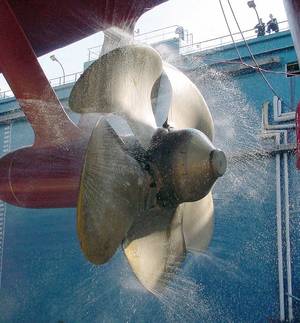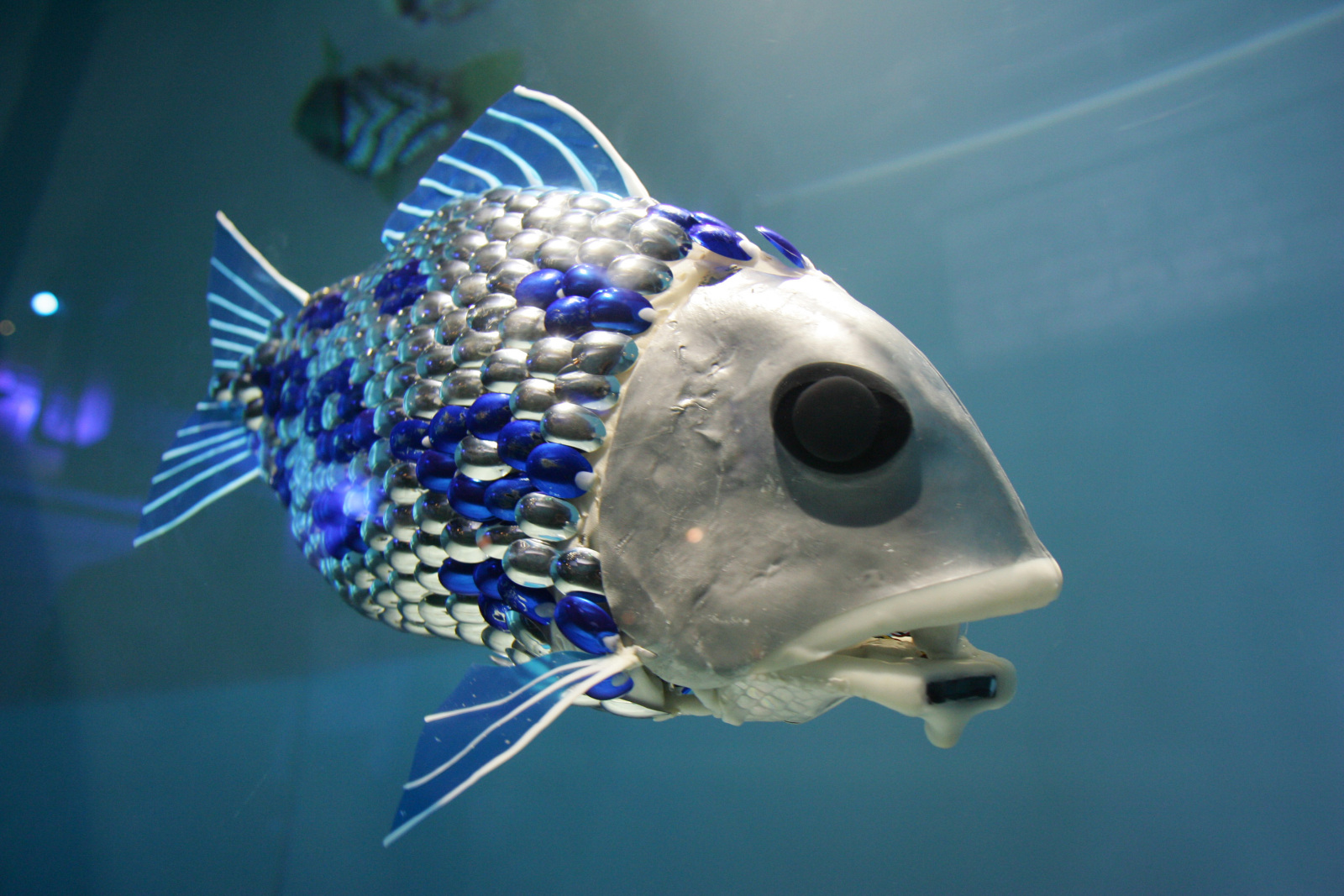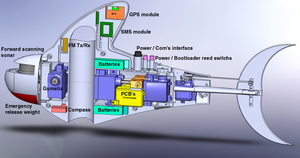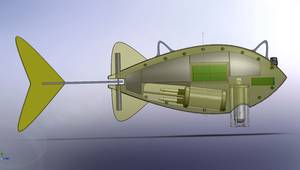Naked Engineering - Robotic Fish
Interview with
Meera - For this week's Naked Engineering, Dave and I are looking into the field of biomimicry. This is a mimicking of biological organisms for their structures or their movements and this week Dave, we're looking into fish.
Dave - Yes. For nearly 200 years, engineers have been optimising one way of moving through water, essentially using a propeller. So we have a spinning propeller which pushes water backwards and you get pushed forwards. Now, nature uses an entirely different system and has spent tens of millions of years optimising this, which instead of using a rotating propeller, you use a flapping tail, and this has got a load of different advantages and disadvantages.
 Meera - Well one scientist looking into this and designing robotic fish is Professor Huosheng Hu at the University of Essex. Now Huosheng, how do fish actually move through water?
Meera - Well one scientist looking into this and designing robotic fish is Professor Huosheng Hu at the University of Essex. Now Huosheng, how do fish actually move through water?
Huosheng - One kind of fish movement is generated by the tail and half of the body. They try to bend the body and tail in an S shape to generate a force and move forward.
Dave - So this is moving side to side and as the tail moves to the left, it's sort of bent to the right so the water kind of falls off the edge and gets pushed backwards, and then as it comes the other way, it generates lift in the other direction. Overall, it gets pushed forwards.
Huosheng - We call this body-tail motion.
Meera - So you first got into this area to make robotic versions of exotic fish. So, how did you even set about an initial design for this?
Huosheng - It's a big challenge to make a robot like a real fish. We cannot have similar muscle like a fish has and so, what we have in hand is only motors.
Meera - So we have one of your earlier designs here in front of us. It's a fish about half a metre in length. It's very aesthetic so it's the shape of a fish, you've got fins on, you've got a nice beautiful tail, blue and silver scales attached onto it as well.
Huosheng - We actually have a rigid head which inside, we put the computers, we put the sensors inside, also, we put the battery inside. And then we have a flexible link, three or four joints with three or four motors, concavely linked together just from the body and the tail section. So this can be driven by the electric power to bend the body like a real fish.
Meera - But I guess it's more than just simply getting this fish to move through the water. It needs to kind of know and direct itself through the water. So just coming out of the mouth here, I can see sensors sticking out and there must be other sensors within all to help it actually know perhaps when an obstacle is coming up or if it's about to bump into something.
 Huosheng - We have four infrared sensors to try to detect obstacle on the way. So, these are navigating sensors. On the other hand, we had a gyroscope inside, we have a pressure sensor inside. This try to control the motion of the fish.
Huosheng - We have four infrared sensors to try to detect obstacle on the way. So, these are navigating sensors. On the other hand, we had a gyroscope inside, we have a pressure sensor inside. This try to control the motion of the fish.
Meera - So initially, you've created this very aesthetic fish here, but there are uses for this in environmental monitoring and the monitoring of water pollution which is what your next generation of fish have been designed for.
Huosheng - What we've tried to do is use a team of robotic fish in the sea port to detect pollution.
Meera - So we're moving out of aquarium tanks, water tanks, out into the sea now. There must be many more challenges and many other factors to consider.
 Huosheng - Once the fish move into the sea, we have to put enough power for the fish to swim against waves, currents, and also, we have to put a lot of sensors inside to actually find a way to go.
Huosheng - Once the fish move into the sea, we have to put enough power for the fish to swim against waves, currents, and also, we have to put a lot of sensors inside to actually find a way to go.
Dave - And I guess navigation is going to be really important and the traditional way of navigating these days using GPS. As soon as you're underwater, it's going to block the microwave signals which carry the GPS. How do you navigate in this kind of environment?
Huosheng - We actually use same principle like a satellite, but instead we used a sonar beacon embedded into the sea ports. Sonar beacons propagate sonar signals. We know each of the beacon's position and each robotic fish has a sonar receiver doing the triangulation.
Dave - So basically, you're putting a load of transmitters your fish can listen to several different transmitters, and work out the time difference between them, and so, from that, it can work out exactly where it is in three dimensional space, but only inside the port.
Huosheng - Yes, exactly. We call this a structured environment.
Meera - You've actually changed a lot of the original structure as well, so the material for example, it's just purely made of carbon fibre. It has this shape and structure of a fish, but there are no aesthetic there. it's purely about handling sea and moving through it.
Huosheng - The fish has to be agile but robust, so we try to make the body rigid.
 Dave - And also looking at the tail, instead of the previous version which had four joints, this seem to be much, much simpler.
Dave - And also looking at the tail, instead of the previous version which had four joints, this seem to be much, much simpler.
Huosheng - We actually first stage - we tried to simplify the driving mechanism from the four joints, reduced to the two joints. Once this is successful, we're looking for more joints to gain more flexibility. This is an engineering compromise.
Meera - What actually are the benefits of using this fish-like structure in order to monitor pollution? What makes them better than propellers?
Huosheng - There are two benefits. Firstly, fish-like movements create no disturbance to the water environment. Secondly, robotic fish can peacefully swim in the port, without causing any danger to the real fish.
Dave - If the fish isn't actually producing an awful lot of turbulence behind it, does that mean that in theory it could be more efficient than a conventional propeller?
Huosheng - In theory, yes because submarines and ships generate a lot of turbulence to the environment and the waves. The efficiency is not very high actually, but real fish, they are very, very efficient swimmers. We are trying to establish how much energy is saved by body movements compared with the thrust or rotational movements. That's our next goal.
Ben - Professor Huosheng Hu from the Computer Science Department at the University of Essex showing Meera and Dave his new generation of robotic fish. You can see the fish in action here.
- Previous Reusing Fish Poo
- Next Fishy vision in the deep sea










Comments
Add a comment